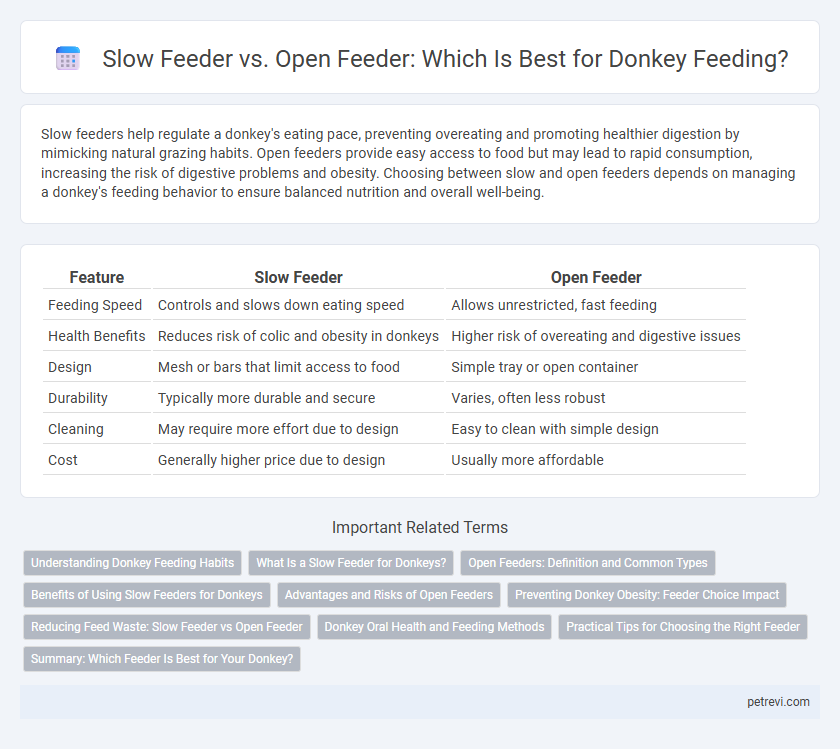Slow feeders help regulate a donkey's eating pace, preventing overeating and promoting healthier digestion by mimicking natural grazing habits. Open feeders provide easy access to food but may lead to rapid consumption, increasing the risk of digestive problems and obesity. Choosing between slow and open feeders depends on managing a donkey's feeding behavior to ensure balanced nutrition and overall well-being.
Table of Comparison
| Feature | Slow Feeder | Open Feeder |
|---|---|---|
| Feeding Speed | Controls and slows down eating speed | Allows unrestricted, fast feeding |
| Health Benefits | Reduces risk of colic and obesity in donkeys | Higher risk of overeating and digestive issues |
| Design | Mesh or bars that limit access to food | Simple tray or open container |
| Durability | Typically more durable and secure | Varies, often less robust |
| Cleaning | May require more effort due to design | Easy to clean with simple design |
| Cost | Generally higher price due to design | Usually more affordable |
Understanding Donkey Feeding Habits
Donkeys have a natural grazing behavior that involves slow, continuous eating to mimic their wild feeding patterns. Slow feeders help regulate intake by extending feeding time and preventing overeating, reducing the risk of obesity and colic. Open feeders allow free access but may lead to rapid consumption and digestive issues due to donkeys' low metabolic rate and selective grazing habits.
What Is a Slow Feeder for Donkeys?
A slow feeder for donkeys is a specially designed feeding device that controls the rate at which the donkey consumes hay or feed, helping to prevent overeating and promote better digestion. These feeders typically feature small openings or mesh that restrict the amount of food accessible at one time, mimicking natural grazing behavior and reducing boredom. Slow feeders improve equine health by minimizing risks of colic, obesity, and digestive disorders commonly associated with rapid feeding.
Open Feeders: Definition and Common Types
Open feeders for donkeys are feeding devices characterized by their exposed design, allowing unrestricted access to hay or grain, which mimics natural grazing patterns. Common types of open feeders include pan feeders, trough feeders, and rack feeders, each varying in height and material to accommodate different stall setups and prevent feed wastage. They are preferred for their simplicity, ease of cleaning, and cost-effectiveness, but require diligent monitoring to avoid overeating and ensure proper nutrition.
Benefits of Using Slow Feeders for Donkeys
Slow feeders for donkeys promote natural grazing behaviors by controlling the intake rate, reducing the risk of obesity and digestive issues like colic and laminitis. These feeders also minimize feed waste and help maintain mental stimulation, supporting overall equine health and well-being. Compared to open feeders, slow feeders enhance nutrient absorption by encouraging longer feeding periods and preventing rapid consumption of food.
Advantages and Risks of Open Feeders
Open feeders offer easy access and allow donkeys to eat at their own pace, promoting natural grazing behaviors and reducing stress. However, the risk of feed contamination from dirt, dust, and rain can lead to spoilage and health issues like colic or respiratory infections. Open feeders also make it harder to control portion sizes, increasing the chance of overeating and weight-related problems in donkeys.
Preventing Donkey Obesity: Feeder Choice Impact
Choosing a slow feeder over an open feeder significantly reduces the risk of donkey obesity by controlling the rate of forage consumption and mimicking natural grazing patterns. Slow feeders promote prolonged eating, preventing rapid overfeeding and encouraging digestion, which supports healthy weight management. In contrast, open feeders allow unrestricted access to food, increasing the potential for overeating and related weight gain in donkeys.
Reducing Feed Waste: Slow Feeder vs Open Feeder
Slow feeders significantly reduce feed waste for donkeys by controlling the intake rate and preventing rapid consumption, which leads to less spillage and undigested feed. Open feeders often cause substantial feed loss as donkeys can easily scatter hay and grain while eating, increasing wastage and feeding costs. Implementing a slow feeder improves feed efficiency, lowers waste, and supports healthier digestion in donkeys.
Donkey Oral Health and Feeding Methods
Using a slow feeder for donkey feeding promotes better oral health by encouraging natural grazing behaviors and reducing the risk of dental issues such as uneven teeth wear and colic. Open feeders allow quicker access to food but can lead to rapid ingestion, increasing the chance of choking and digestive problems in donkeys. Prioritizing slow feeding methods supports gradual food intake, mimics natural feeding patterns, and helps maintain optimal dental and gastrointestinal health in donkeys.
Practical Tips for Choosing the Right Feeder
Slow feeders for donkeys reduce overeating and minimize colic risk by controlling feed intake, while open feeders allow easy access but may lead to rapid consumption and waste. Choose a slow feeder if your donkey tends to eat quickly or has metabolic issues, ensuring the design fits the donkey's size and feeding habits. Open feeders suit environments where natural grazing is limited, but maintaining cleanliness is crucial to prevent contamination and health problems.
Summary: Which Feeder Is Best for Your Donkey?
Slow feeders promote healthier digestion and reduce boredom by encouraging natural foraging behavior and limiting rapid intake, making them ideal for donkeys with a tendency to overeat or prone to digestive issues. Open feeders provide easy access to larger quantities of feed but may increase the risk of overeating and lack the enrichment that slow feeders offer. Choosing the best feeder depends on your donkey's eating habits, health needs, and behavior, with slow feeders generally recommended for controlled, balanced feeding.
Slow Feeder vs Open Feeder for Donkey Feeding Infographic

 petrevi.com
petrevi.com